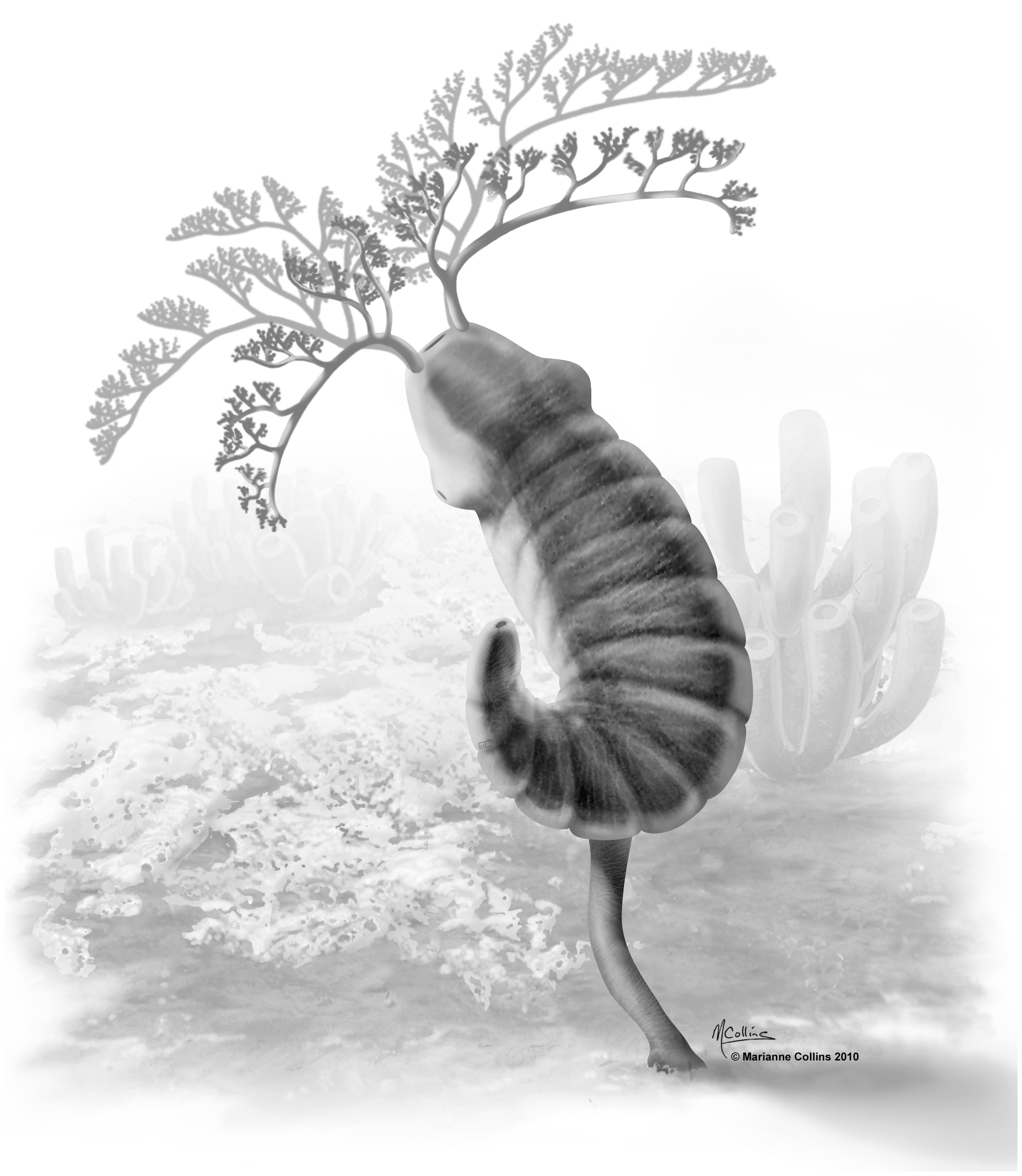Herpetogaster on:
[Wikipedia]
[Google]
[Amazon]
''Herpetogaster'' is an
 '' H. collinsi'' is known from over 101 specimens. It possessed a pair of branching tentacles and a tough but flexible body that curved helically to the right like a ram's horn and was divided into at least 13 segments. A flexible, extensible
'' H. collinsi'' is known from over 101 specimens. It possessed a pair of branching tentacles and a tough but flexible body that curved helically to the right like a ram's horn and was divided into at least 13 segments. A flexible, extensible
''Herpetogaster''
at the Fossil Wiki. {{Taxonbar, from=Q5743704 Fossil taxa described in 2010 Burgess Shale fossils Prehistoric animal genera Cambrian genus extinctions it:Herpetogaster collinsi
extinct
Extinction is the termination of a kind of organism or of a group of kinds (taxon), usually a species. The moment of extinction is generally considered to be the death of the last individual of the species, although the capacity to breed and ...
cambroernid
The cambroernids are an informally-named clade of unusual Paleozoic animals with coiled bodies and filamentous tentacles. They include a number of early to middle Paleozoic (Cambrian to Devonian) genera noted as 'bizarre" or "orphan" taxa, meani ...
genus
Genus ( plural genera ) is a taxonomic rank used in the biological classification of living and fossil organisms as well as viruses. In the hierarchy of biological classification, genus comes above species and below family. In binomial nom ...
of animal from the Early Cambrian
The Cambrian Period ( ; sometimes symbolized Ꞓ) was the first geological period of the Paleozoic Era, and of the Phanerozoic Eon. The Cambrian lasted 53.4 million years from the end of the preceding Ediacaran Period 538.8 million years ago ...
Chengjiang biota
The Maotianshan Shales are a series of Early Cambrian deposits in the Chiungchussu Formation, famous for their '' Konservat Lagerstätten'', deposits known for the exceptional preservation of fossilized organisms or traces. The Maotianshan Shales ...
of China, Pioche Formation of Nevada and Middle Cambrian
Middle or The Middle may refer to:
* Centre (geometry), the point equally distant from the outer limits.
Places
* Middle (sheading), a subdivision of the Isle of Man
* Middle Bay (disambiguation)
* Middle Brook (disambiguation)
* Middle Creek ( ...
Burgess Shale
The Burgess Shale is a fossil-bearing deposit exposed in the Canadian Rockies of British Columbia, Canada. It is famous for the exceptional preservation of the soft parts of its fossils. At old (middle Cambrian), it is one of the earliest fo ...
of Canada containing the species ''Herpetogaster collinsi'' and ''Herpetogaster haiyanensis''.
Description
 '' H. collinsi'' is known from over 101 specimens. It possessed a pair of branching tentacles and a tough but flexible body that curved helically to the right like a ram's horn and was divided into at least 13 segments. A flexible, extensible
'' H. collinsi'' is known from over 101 specimens. It possessed a pair of branching tentacles and a tough but flexible body that curved helically to the right like a ram's horn and was divided into at least 13 segments. A flexible, extensible stolon
In biology, stolons (from Latin '' stolō'', genitive ''stolōnis'' – "branch"), also known as runners, are horizontal connections between organisms. They may be part of the organism, or of its skeleton; typically, animal stolons are external s ...
emerged from the body at about the ninth segment and secured the animal to the sea floor, often by attaching to the sponge
Sponges, the members of the phylum Porifera (; meaning 'pore bearer'), are a basal animal clade as a sister of the diploblasts. They are multicellular organisms that have bodies full of pores and channels allowing water to circulate throu ...
'' Vauxia.'' It is not known whether the attachment was permanent.
A mouth opened between the tentacles, leading internally to a pharynx, a large lentil-shaped stomach, a narrower straight intestine, and an anus at the end of the "tail." The tentacles were softer than the body and probably extensible. A dark line running down the center of each tentacle and connecting with the head is tentatively reconstructed as a hydrostatic canal and/or vascular system; if this interpretation is correct, the tentacles might have been controlled by fluid pressure, and individuals could have fed by snaring either small prey or edible particles in the tentacles and bringing the tentacles to the mouth, as in living sea cucumbers. Structures on the back of the head have been noted as potential pharyngeal pores, which suggests a relationship with early echinoderms. The whole animal was 3-4 cm long. They were probably gregarious, as up to eight individuals have been found on the same slab. The Six specimens of ''Herpetogaster'' are known from the Greater Phyllopod bed
The Phyllopod bed, designated by USNM locality number 35k, is the most famous fossil-bearing member of the Burgess Shale fossil ''Lagerstätte''. It was quarried by Charles Walcott from 1911–1917 (and later named Walcott Quarry), and was t ...
, where they comprise less than 0.01% of the community.
References
External links
*''Herpetogaster''
at the Fossil Wiki. {{Taxonbar, from=Q5743704 Fossil taxa described in 2010 Burgess Shale fossils Prehistoric animal genera Cambrian genus extinctions it:Herpetogaster collinsi